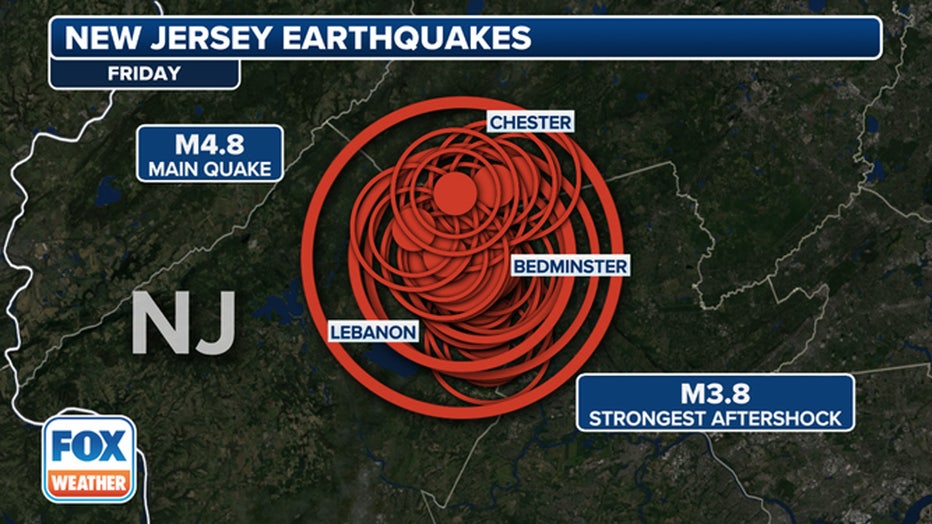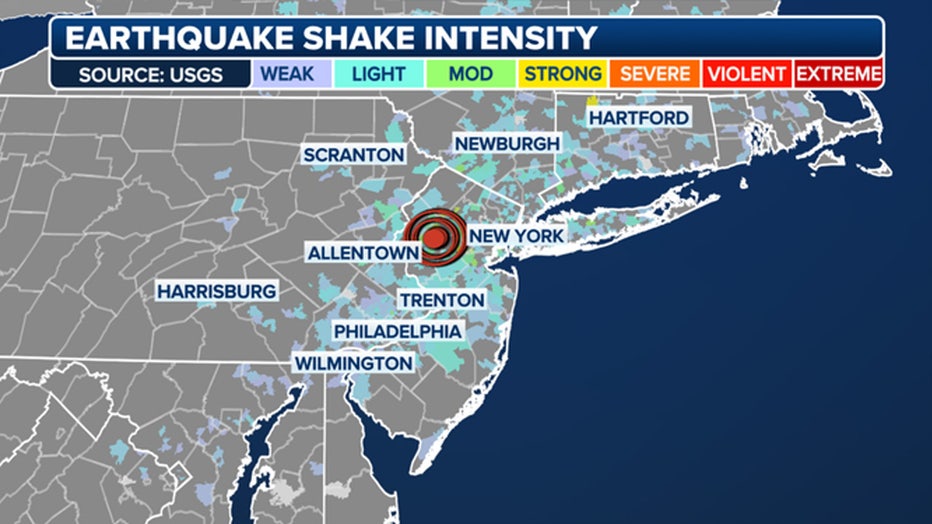NJ fault line discovery: Explaining unusual NYC area shaking from April's earthquake

Expert explains earthquake felt in NYC
Steve Holler, an associate professor at physics and engineering at Fordham University, explains what New Yorkers should know about a 4.8M to earthquake.
NEW JERSEY - The discovery of a new fault line may explain the unusually strong and displaced shaking from April’s magnitude 4.8 earthquake that struck the heart of New Jersey, yet was felt the strongest miles away from the epicenter, a new research study shows.
The quake struck on April 5 in the late morning, centered in Tewksbury Township, but the quake sent shockwaves through New York City 40–50 miles away and caused some damage in Brooklyn and Newark.
According to U.S. Geological Survey estimates, it was the strongest quake in the region since 1884, shaking around 42 million people. The USGS said 184,000 people reported they felt the quake, a record number to fill out the report.

New Jersey earthquakes and aftershocks from the main 4.8 quake on April 5, 2024. (FOX Weather)
However, researchers who went to the epicenter were puzzled to find there was very little shaking and no discernible damage reported.
"We expected some property damage - chimneys knocked down, walls cracked or plaster fallen, but there were no obvious signs," study coauthor Wong-Young Kim of Columbia Climate School’s Lamont-Doherty Earth Observatory said in a press release announcing the study results. "We talked to police officers, but they were not very excited about it. Like nothing happened. It was a surprising response for a magnitude 4.8 earthquake."

A shake intensity map from the USGS from a 4.8 earthquake that hit New Jersey on April 5, 2024. (FOX Weather)
Kim’s study said that based on existing models, the quake should have done substantial damage at the epicenter. Surface motion generated by quakes is measured on the 10-point Modified Mercalli Intensity Scale, and this quake should have brought Level 7 or "very strong" shaking within 6 miles of the epicenter, Kim said.
However, no one at or around the epicenter reported intensity 7 shaking or anything close to it, according to the release. Damage was limited to minor cracking in some drywall and a few items knocked off shelves.
But instead, three row homes were damaged in Newark, and New York City residents reported shaking on par with a level 4 on the Mercali scale and about 150 buildings reported minor damage. Even New Hampshire reported level 3 shaking some 280 miles away, the release said.
"So, lots of puzzling why many people felt it in the Northeast, (but) much less people felt it down south to Philadelphia and further south to Virginia – much less than people in the Northeast," Kim told FOX Weather on Friday. "As well as very little damage around the epicenter area."
Quake waves went in a different direction
Kim says a typical earthquake would send much of its energy straight up to the surface, which usually makes the epicenter the most dangerous place to be.
But in this case, the energy was sent downward until it reached the boundary between the Earth’s crust and mantle about 20 miles underground. There the energy wave bounced back up, emerging under the New York City area for the big jolt there.
Featured
Can destructive earthquakes hit NYC? Here's what experts say
Could an earthquake hit NYC? Experts explain why quakes are just as common on the East Coast as they are on the West Coast.
After another downward cycle, the wave re-emerged a bit weaker in New England, repeating the cycle until the energy dissipated.
Kim’s team’s analysis suggests the quake took place on a previously unmapped fault that runs south to north. But unlike traditional faults that run vertically, this one dips eastward into the Earth at about a 45-degree angle, sending the energy in unusual directions.
"In this case, on the 45-degree incline of the fault, the energy headed to the northeast direction and into the deep," Kim told FOX Weather.
How do Northeast quakes differ from California's temblors?
Unlike the quakes that rattle California and the West Coast with relative frequency and are caused by moving tectonic plates, Northeast quakes are leftover from ancient fault zones stretching back 200 million years, researchers said.
That’s when what is now Europe tore away from North America, the study said. Some areas are still settling and readjusting all these years later, triggering occasional earthquakes.
Kim’s colleagues have calculated that a quake of April’s magnitude occurs about once every 100 years, but suggest the region could see quakes as large as a magnitude 6 every 700 years, and up to a magnitude 7 every 3,400 years.
"No one knows if such quakes have occurred in human time or could," Kevin Krajick, the author of the press release wrote. "But if one did, it would be catastrophic."
In the wake of the quake, researchers placed a temporary network of dozens of seismometers near the epicenter to measure the dozens of subsequent aftershocks, hoping to better map the region’s faults.

Why are there Earthquakes in NJ?
FOX 5 NY's Aubrey Puente looks into the Ramapo fault line the largest system of cracks in the Northeast.
The data may trigger the need to re-evaluate how future quakes would impact the populous Northeast.
"Some (quakes) that are not even that big could maybe focus energy toward population centers," Kim said. "If [the April] earthquake was just a little stronger, or a little closer to New York City, the effect would be much greater. We need to understand this phenomenon and its implications for ground motion prediction."
FOX Weather helped contribute to this report.


